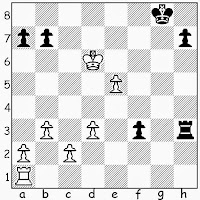Philidor 1792 - guest1416
3 0 blitz, www.bereg.ru, 2013
1.e4 e5 2.Nf3 Nc6 3.Nc3 Nf6 4.a3
Here we have Gunsberg's Variation of the Four Knights Game, explored (among other places), along with other double e-pawn openings, in Hugh Myers' 1977 Reversed King Pawns, Mengarini's Opening.
White prepares to take the "black" side of the positions that
develop, hoping to be helped by his "extra" pawn move. Black prepares to play...
4...Bc5
...a reversed Italian game, and, after...
5.Bc4 Bxf2+
...he uncorks a Reversed Italian Four Knights Jerome Gambit!
The only "reversed" Jerome Gambit that I can find in The Database at this point are lixuanxuan - Polone, blitz, FICS, 2012 (0-1, 27), which began 1.e4 e5 2.Nf3 Nc6 3.Nc3 Bc5 4.Bc4 Bxf2+ ; and Diophantos - khangaza, blitz, FICS, 2007 (0-1, 34), which began 1.e4 e5 2.Nf3 Nc6 3.Nc3 Bc5 4.Bc4 Nf6 5.d3 Bxf2+.
Of course, that is not to overlook games like Krejcik, Josef - Baumgartner, Troppau, 1914 1.e4 e5 2.Nf3 Bc5 3.Nxe5 Bxf2+ 4.Kxf2 Qh4+ 5.g3 Qxe4 6.Qe2 Qxh1 7.Bg2 Black resigns. For a discussion of the Busch - Gass Gambit, see "Worth A Second Look" Parts 1, 2 and 3.
6.Kxf2 Nxe4+ 7.Nxe4 d5 8.d4
Following along the lines of ideas for Black in the regular Jerome Gambit, White could play 8.Bd3 dxe4 9.Bxe4 or 8.Bxd5 Qxd5 9.d3, but, instead he plays the blow-it-up variation - see perrypawnpusher - Marcym, blitz, FICS, 2010 (1-0, 20) and perrypawnpusher - NimbusReign, blitz, FICS, 2010 (0-0, 26). Why not, he's ahead a couple of pieces, right?
8...exd4
A better idea, according to Houdini, was 8...dxe4 9.Nxe5 Qf6+ 10.Ke1 Be6 11.Bxe6 Qxe6 12.Nxc6 Qxc6, although, despite White's King's central residence, the first player's extra piece still outweigh's Black's extra pawn.
9.Ng3
Solid, but missing 9.Bg5!? when 9...f6 allows a brutal attack 10.Nxf6+ gxf6 11.Re1+ Kf8 12.Bh6+ Kg8 13.Bxd5+ Qxd5 14.Re8+ Kf7 15.Rxh8, according to the computer. That would be a lot for a person to see in a 3-minute game.
9...dxc4 10.Re1+ Be6 11.Kg1 0-0
White has castled-by-hand and might actually believe that his extra piece is worth more than Black's extra three "Jerome pawns". The psychological reversal might have been difficult, with the Jerome-player facing the Jerome.
12.Ng5 Bd5 13.Nf5 Qf6 14.Qg4 Ne5
Instead, 14...Rad8 or 14...Rae8 would have probably kept the game even.
15.Qh3
White presses his counter-attack against the (reversed) Jerome. In a slower game, he might have risked 15.Rxe5!? Qxe5 16.Bf4 h5 (16...Qf6 17.Nxh7 Kxh7 18.Bg5 Qe6 19.Qh5+ Kg8 {19...Qh6 20.Bxh6 g6 21.Qh4 gxf5 22.Bg5+ Kg7 23.Qh6+ Kg8 24.Bf6 Bc6 25.Qg7#} 20.Ne7+ Qxe7) 17.Bxe5 hxg4 18.Ne7+ Kh8 19.Nxd5 with advantage.
15...h6 16.Ne4 Qe6 17.Kh1
Safety first - and an even game. Again, with time to burn, Philidor 1792 would certainly have found 17.Bxh6!? Ng6 (17...gxh6 18.Nxh6+ Kg7 19.Nf5+ Kg8 20.Ng5) 18.Neg3, etc.
17...Ng6 18.Nxd4 Qxh3 19.gxh3 Rae8
Black is now clearly better.
20.Kg1 Rxe4 21.Rxe4 Bxe4 22.Nb5 c6 23.Nd6 Bxc2 24.Nxc4 Rd8 25.Be3 b6 White lost on time
(Another Random Note: May, 2011, had been the month, so far, with the most page views for this blog since it started in June, 2008 . However, last month November, 2013, overtook it, becoming the month with the most views - until December 2013, which has surpassed both to become Number 1! My "Welcome!" and "Thank You! to everyone stopping by. - Rick)



















































